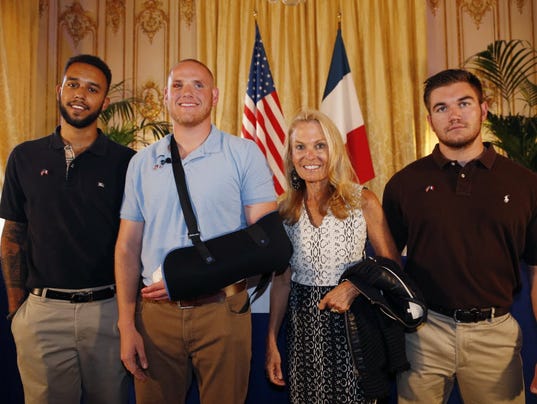"Three Marines stop terrorist on French train" was the gist of the first headlines on this weekend’s counterterrorism story. But when the actual facts came out, the story got even better.
As it turns out, it wasn’t three Marines. It was two U.S. service members — from the National Guard and the Air Force — and their civilian buddy from middle school. And they had the help of a traveling British businessman.
The three were riding on a train from Amsterdam to Paris when a gunman — an Islamist from Morocco who had visited Syria and was flagged as a possible jihadist— started shooting. One of the Americans, Airman 1st Class Spencer Stone, 23, sprinted at the gunman and tackled him. The others, Oregon National Guardsman Alek Skarlatos, 22, and Sacramento State University student Anthony Sadler, 23, joined in.
As Skarlatos recounted in a Sky News interview from his hotel in Arras, northern France: "I just looked over at Spencer and said, 'Let's go!' Spencer got to the guy first, grabbed the guy by the neck, and I grabbed the handgun, got the handgun away from the guy and threw it. Then I grabbed the AK (assault rifle), which was at his feet, and started muzzle thumping him in the head with it."
Stone was cut by the attacker behind his neck, and his thumb was nearly sliced off as the man was wrestled to the ground by the Americans. Sadler said: "The gunman pulls out a box cutter and slices Spencer a few times." He added that the attacker "never said a word."
To Americans who remember Sept. 11, 2001, this kind of response — even down to the “let’s go” — echoes the story of Todd Beamer and the passengers of Flight 93. It’s the right response, of course, to terrorists who threaten innocents.
As Brad Todd wrote days after 9/11, it was the response of ordinary Americans on this flight that meant a repeat of the attacks was much less likely: “Just 109 minutes after a new form of terrorism — the most deadly yet invented — came into use, it was rendered, if not obsolete, at least decidedly less effective. ... United Flight 93 did not hit a building. It did not kill anyone on the ground. ... Why? Because it had informed Americans on board who'd had 109 minutes to come up with a counteraction. And the next time a hijacker full of hate pulls the same stunt with a single knife, he'll get the same treatment and meet the same result as those on United Flight 93. Dead, yes. Murderous, yes. But successful? No.”
Meanwhile, the expensive global security establishment failed to stop 9/11, and —despite having the French-train gunman flagged as a possible jihadist— did nothing to stop this weekend's attack. And that’s a lesson.
Bureaucracies have their place, but they don’t deal well with diffuse threats such as terrorism. By the time “first responders” get there, it’s usually too late. But there’s one group of “responders” who don’t have to go anywhere, and that’s the group already on the scene. In conventional analysis, and in the terrorists’ hopes, those people are called “victims.” But as the three Americans on that French train demonstrated, victimhood isn’t the only response.
And there’s more. The purpose of terror is to terrorize. But responding appropriately has the opposite effect. The response of British businessman Chris Norman , who helped subdue the attacker, illustrates this: “Norman said his first reaction was to hide," The Fiscal Times reported. "But after he saw the Americans fighting the attacker, he said he went to help them.”
Fear is contagious. But so is courage. People should respond not like a herd of sheep but like a pack of wolves. When the follow-up report on the 2001 attacks came out, J.B. Schramm noted in The Washington Post that "on Sept. 11, 2001, American citizens saved the government, not the other way around.” Intelligence agencies failed. Air defense systems failed. But: “Requiring less time than it took the White House to gather intelligence and issue an attack order (which was in fact not acted on), American citizens gathered information from national media and relayed that information to citizens aboard the flight, who organized themselves and effectively carried out a counterattack against the terrorists, foiling their plans. Armed with television and cellphones, quick-thinking, courageous citizens who were fed information by loved ones probably saved the White House or Congress from devastation.”
Glenn Harlan Reynolds, a University of Tennessee law professor, is the author of The New School: How the Information Age Will Save American Education from Itself and a member of USA TODAY's Board of Contributors.
In addition to its own editorials, USA TODAY publishes diverse opinions from outside writers, including our Board of Contributors. To read more columns like this, go to the Opinion front page.

No comments:
Post a Comment